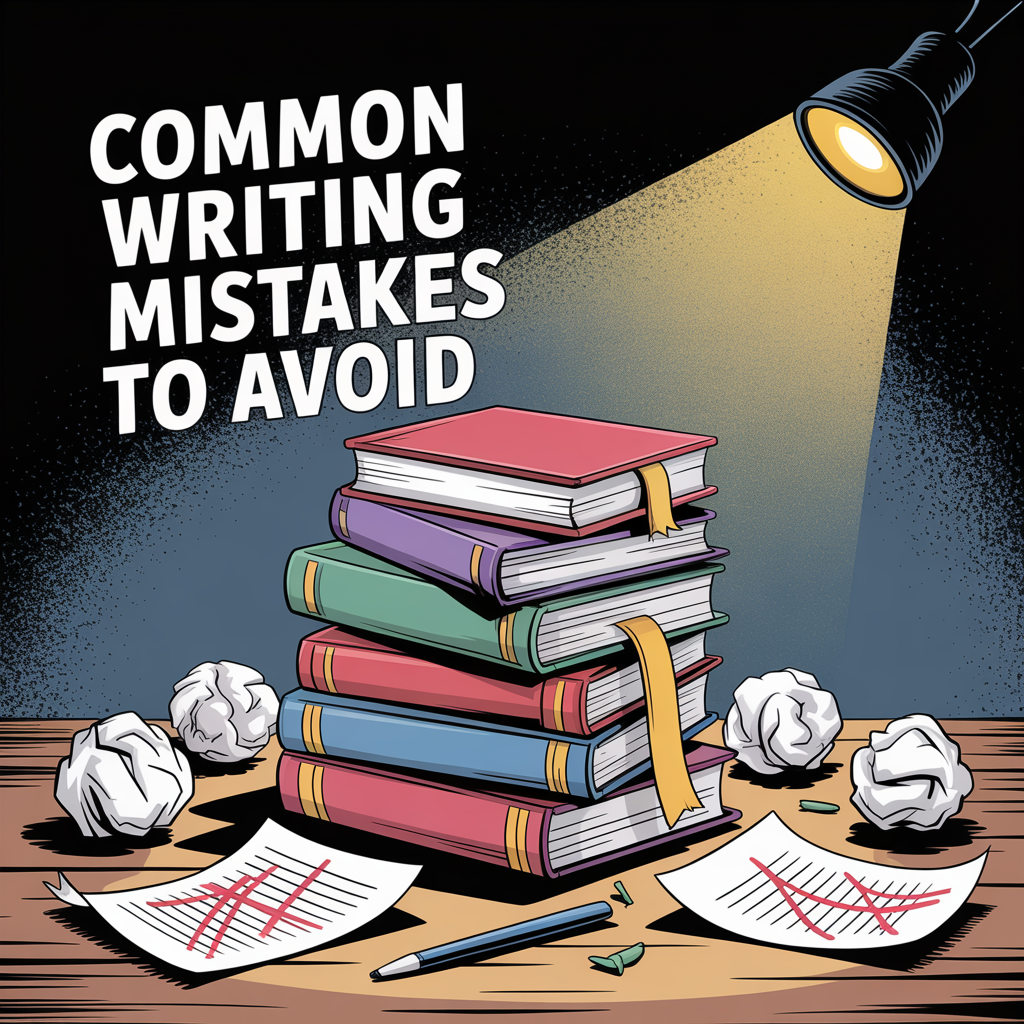Common Writing Mistakes To Avoid

No matter how experienced you are as a writer, we all slip up sometimes. Whether you’re crafting a blog post, polishing an email, or working on a manuscript, small writing mistakes can creep in and chip away at the clarity, professionalism, and impact of your message. The good news? Most of these missteps are easy to fix once you know what to look for. In this post, we’ll shine a light on some of the most common writing mistakes, such as inconsistent tenses, vague wording, and punctuation blunders, and show you how to avoid them. Sharpen your skills and strengthen your voice with simple strategies that can make a big difference in your writing.
The Art of Consistency: Avoiding Inconsistent Tense Usage
Maintaining consistent tense throughout your writing does wonders for clarity and ease of reading. It’s like when you’re talking to someone, and they switch stories halfway—confusing, right? That’s precisely how inconsistent tenses can make your readers feel lost in a time warp.
When you’re writing, picking a tense and sticking to it helps readers follow your narrative without hiccups. If you’re telling a story that happened in the past, keep it in the past tense. Jumping back and forth between present and past can make your text feel disjointed.
It’s easy to get carried away, especially with longer pieces. One minute you’re describing a main character’s action in the past, and the next, you’re slipping into what’s happening right now. However, tools like Grammarly can be your vigilant assistant, catching those sneaky tense changes you might miss and providing reassurance in your writing process.
Here’s a handy tip: read through your work with an eye for time changes. If you’re jumping around on the timeline, your message might lose its punch. Maintaining the same tense not only creates a smoother flow but also fosters a stronger connection with your audience, keeping them engaged and your point clear.
Practicing this consistency makes it part of your writing habit. Use resources like writing workshops or online grammar trackers to polish this skill. Your future self will thank you for it, and so will your readers, who won’t be left guessing about the when of your tale.
Grammar Gremlins: Common Grammatical Errors and How to Fix Them
Grammar mistakes can slide into your writing like ninjas, sneaking in unnoticed until it’s too late. These little gremlins can mess up your message and even shake your credibility if you’re not careful.
Some of the most common slip-ups are mixing up ‘your’ and ‘you’re,’ ‘its’ and ‘it’s,’ or getting creative with comma splices. Even seasoned writers run into these hiccups. Spotting these errors is the first step to fixing them and maintaining a sharp appearance in your writing.
Grammar isn’t just about rules. It’s about making your writing clear and compelling. When your grammar game is weak, your ideas can get lost in translation. That’s why brushing up on these skills is a win for anyone looking to be taken seriously in their writing projects.
There are loads of resources out there to help. Online tools like Grammarly are your grammar best friends. They not only help spot errors but often explain why something is wrong. It’s learning as you go, fixing slip-ups while also leveling up your skills.
Reading well-edited content is another way to subconsciously absorb the nuances of grammar. Whether it’s a favorite blog, a novel, or professional articles, you’ll start to notice patterns and rules in action. Plus, don’t shy away from grammar courses or workshops if you really want to go pro.
Getting the hang of grammar takes time, and everyone is human. I’ve tripped over plenty of commas and semicolons myself. But keeping your head in the game and using all the tools at your disposal can help you tackle those grammar gremlins head-on, turning your writing into the smooth, polished piece it deserves to be.
Syntax Simplified: Navigating Complex Sentences
Sometimes, crafting sentences feels like juggling flaming torches—trying to balance what you’re saying with how you’re saying it. Complex sentences can intrigue your readers, sure, but overdo it, and your audience might need a map to follow your thoughts.
Long, winding sentences might look impressive, but they can quickly become a chore for readers to untangle. When each sentence drags on, stacked with commas, conjunctions, and clauses, it’s like trying to read through a maze. Simplicity is often your best friend.
Breaking down those colossal sentences into more digestible pieces usually makes your content clearer. Not every sentence needs to be short. Varying your sentence length is key to maintaining a rhythm without losing your reader in a labyrinth of words.
When you’re editing, take a step back and look for sentences that might go on a joyride. Cut them into tidier, more manageable bites. Read your work out loud to catch places where you might run out of breath. It’s a quick way to spot where sentences could be simplified.
You might be tempted to show off your vocabulary and structure skills, but remember clarity tops complexity any day. Short and sweet sentences pack a punch and get your point across without the extra fluff.
If you’re struggling with sentence structure, resources abound. Plenty of online courses help refine syntax, and reading well-edited prose can constantly expose you to practical ways of sentence construction. It all helps in honing a style that’s both sophisticated and straightforward, keeping your readers engaged while conveying your message effectively.
The Perils of Passive Voice: When and How to Use Active Voice
Passive voice can turn your writing into a bland plate of words that might lose your reader’s interest. Think of it like a one-sided conversation where the key player is missing, leaving the audience guessing ‘who did what?’
Active voice, on the other hand, is like a direct conversation, straight to the point, engaging, and often more exciting. It lays it all out clearly: subject, action, object. ‘A dog chased the ball’ hits differently than ‘The ball was chased by the dog’, right?
Going active isn’t just about jazzing things up. It’s also about clarity and engagement. Active voice can make your sentences more direct and vigorous, which helps keep readers engaged and your point sharp.
But hey, the passive voice isn’t the villain. Sometimes, it’s perfect for when the action matters more than who did it. In scientific writing, phrases like ‘The solution was heated to 80 degrees’ keep the focus where it needs to be.
Next time you’re writing, look out for passive constructions that might be weighing down your sentences. A quick test is asking, ‘Who did the action?’ If the answer isn’t clear, it might be time to shift gears.
To master this balance, practice is crucial. Try rewriting passage segments using both voices and see how the tone changes. You’ll soon get a feel for when passive serves your purpose and when active voice is the way to go.
Online resources can help reinforce this concept, offering exercises and examples to hone your skills. As you add this tool to your writing belt, you’ll see your content shine with clarity and vigor, pulling readers in rather than pushing them away.
The Clarity Conundrum: Avoiding Ambiguity in Writing
Ever had a conversation where you’re left puzzled about the actual point? That’s the muddle of ambiguity that can weave into your writing. Without clarity, your message might get tangled, leaving your readers scratching their heads rather than nodding along.
Ambiguity often sneaks in through vague wording or when multiple interpretations hide in a sentence. It’s like saying something without really saying it and hoping the audience fills in the gaps you left wide open.
You’re aiming for clear communication. To start, be precise with your language. Choose words that leave little room for double meanings. Instead of ‘soon,’ consider ‘within the next week’—it’s the specificity that cuts through the fog.
Having a clear structure to your piece also works wonders. Each section and paragraph should flow logically, like stepping stones across a river, leading your readers effortlessly along your narrative.
Knowing your audience also fuels clarity. Is your language tailored to what they understand? What’s clear to one group might sound Greek to another. Tailor your terminology to the knowledge base of your audience. It makes the reading experience smooth and engaging.
Before you hit ‘send’ or publish, proofreading is your best friend. Fresh eyes—or even someone else’s—can help spot fuzzy phrases you might have overlooked. Sometimes, just a slight tweak can turn ambiguity into crystal-clear communication.
Resources like style guides or writing apps offer tips and checks for ambiguous phrases. As with all writing skills, the goal is to get sharper with practice, turning your writing into a beacon of clarity that your readers can follow without a hitch.
Avoiding the Repetition Trap: Strategies for Varied Vocabulary
Falling into the pitfall of using the same words or phrases over and over isn’t just boring for your readers—it can also make your writing sound flat and uninspired. If your vocabulary feels like it’s on repeat, it’s probably time for a refresh.
When you hit ‘replay’ on words too often, it can stick out to readers like a sore thumb. It’s like hearing the same song on a loop; the novelty wears off quickly. Diversifying your vocabulary means keeping your audience on their toes and engaged with new, vibrant language.
Building up a varied vocabulary doesn’t mean reaching for the thesaurus at every turn, though. It’s about finding words that fit seamlessly into your context, not just trying to sound clever. Taking the time to read widely across genres can introduce you to new terms naturally and comfortably.
Another tactic is to challenge yourself. Take a few overused words from your latest draft and actively replace them with alternatives. But make sure these substitutes don’t disrupt the flow or tone of your piece. The goal is natural variety, not forced complexity.
Expanding your vocabulary also involves being conscious of context. Choose words that not only switch things up but also enhance the meaning you’re trying to convey. Scrutinize sentence structures and narrative pacing, ensuring they weave your varied vocabulary tightly into the narrative.
There are numerous tools and games available, from vocabulary apps to word-a-day calendars, all designed to make learning new words less of a chore and more of a journey. Embrace them to inject freshness into your writing style.
With practice, your writing will begin to reflect this enriched vocabulary, drawing readers in with its originality and flair. It’s not just what you say but how you say it that can transform your writing from ordinary to extraordinary.
Punctuation Perils: Understanding the Basics and Beyond
Punctuation marks might seem like mere writing accessories. Still, they play a pivotal role in directing the flow and tone of your text. With a single comma, you can change a sentence’s entire meaning or clarity. Messing these tiny helpers up might cause your readers to take a wrong turn on your narrative journey.
Common problems arise with the misuse of commas, semicolons, and apostrophes, often leading to confusion or even comedic misunderstandings. Take the infamous ‘Let’s eat, Grandma’ versus ‘Let’s eat Grandma’ example. A tiny comma makes a world of difference.
A solid grasp of punctuation affects your writing’s readability and professionalism. When used correctly, your content is seamless—each mark guiding readers smoothly through your thoughts and ideas.
Always start with the basics. Know when to use periods, commas, and apostrophes, and beware of overusing exclamation points—they can dilute their impact if tossed around too freely.
To improve your punctuation skills, consider proofreading with a specific focus on punctuation. Read aloud to hear where natural pauses or emphasis fall. Keep style guides handy for a quick reference to standard punctuation rules.
Invest time in punctuation exercises or online quizzes to reinforce these skills. Don’t hesitate to ask for feedback from readers or peers who can provide a fresh perspective on how your punctuation habits are holding up.
Developing a keen eye for punctuation might take practice, but it’s worth it. Your sentences will sing, your ideas will flow, and your audience will appreciate that you took the time to get it right.
Fact Over Fiction: The Significance of Accuracy and How to Verify Sources
Getting facts wrong in your writing is like planting seeds of doubt among your readers. When the foundation of your content is shaky, it can erode trust and the overall value of your work. Today’s savvy readers prefer content that not only entertains but also accurately informs.
Factual accuracy isn’t reserved just for journalistic pieces or academic writing. Whether you’re crafting a blog post or business report, getting your details right is crucial. It’s about building credibility and showing that you’re a reliable source of information.
Verifying information starts with choosing reputable sources. Reliable content often references where the data comes from, grounding your claims in evidence that others can also confirm. Think of this as the backbone of your content engine—without it, your writing can fall flat.
In a world where misinformation spreads like wildfire, equipping yourself with fact-checking tools is invaluable. Websites like Snopes or FactCheck.org can help sift through headlines and statistics, ensuring what you share isn’t fiction dressed up as fact.
Building a network of expert contacts for specific topics can also be beneficial. Experts can offer insights that not only enhance your accuracy but also add depth to your content. This network becomes a resource pool whenever you’re covering complex or unfamiliar subjects.
And don’t hesitate to seek a second opinion. Asking peers to review your claims can help unearth inaccuracies or provide fresh angles that enhance the quality of your content. Two or more sets of eyes are more likely to catch what one might miss.
By taking these steps, you lay the groundwork for writing that informs, engages, and withstands scrutiny. Your readers will thank you, and your reputation as a trustworthy writer will grow solid roots, nourished by the power of accuracy and authoritative content.
Conclusion
Great writing isn’t about being perfect—it’s about being clear, engaging, and intentional. By paying attention to the common pitfalls we’ve covered, such as tense shifts, grammar slip-ups, run-on sentences, passive voice, vague language, repetitive word choice, poor punctuation, and factual inaccuracy, you’re already a step ahead. Writing is a craft, and every revision is a chance to improve. Keep honing your skills, use the tools available to you, and don’t be afraid to ask for feedback. The more aware you become of these common mistakes, the more confident and effective your writing will be. Your readers and your future self will thank you.






